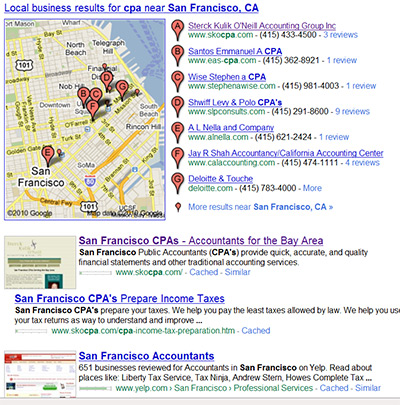SEO New Client Checklist
Whether you hire an Search Engine Optimization service/specialist or do it yourself, there’s a list of initial tasks to accomplish in order to start moving your site to the top of Google’s result pages. I am going to use the checklist below as an outline for a call later today to a prospective client who wants her site to start showing up on Google. It’s what SEO specialists do, but there’s nothing secret about it!
Go ahead! Try your own hand at being a SEO expert! Here’s what to do:
- Determine what keyword phrases you want each of your web pages to be tuned for. Each page can be tuned for one set of keywords (read why), and the selection of appropriate keywords is critical. If possible, you want to identify the keywords relating to your service and products which have a high number of Internet searches and a low number of competing sites. You also need to consider tuning your pages for longer phrases which narrow the search to your geographic area or product specialty.
- Tune your home page for the most important keyword phrase. Then in your first pass tune 2 – 4 more pages for other important keywords.
- To tune a page:
- Lead with keyword phrase in the page <title> tag. “Lead” means that the phrase should come first in the text, not at the end of a title, header, paragraph, etc.
- Lead with the keyword phrase in the <h1>header at the top of the page and in the leading <h2> header and top <p>paragraph text.
- Lead with the keyword phrase in the ALT and TITLE tags that are part of each <img> image on your page.
- Write a <meta name=”description” content=”How…”> description meta tag that leads with the keyword phrase.
- Make sure that each page has at least 300 words of relevant text. Google likes wordy pages.
- Ensure that any content provided by Flash or video is also present in low-tech text. Search engines don’t do a good job understanding and indexing non-text content.
- If you are a business with a bricks and mortar presence, fill out your profile on Google Places, Bing, City Search, and Yelp.
- Develop a strategy to acquire quality in-coming links to each tuned page on your site.
- Develop a strategy to update each tuned page monthly. Google ranks freshly updated pages higher than stale pages, so we need to find a way to include new content on the pages as often as reasonable.
Some SEO companies say simply, “Trust us and we’ll get you to the top of Google.” Then they take your money and do their “magic”. Of course, there is no magic, and perhaps your site will rise somewhat in Google’s results, but sometimes not much will happen.
I believe in outlining the approach to clients and letting them make key decisions. Deciding how much of their time and money to spend in optimizing the site is an area that I rely on the client’s judgment. By laying out the tasks, the client can decide how much outside support they want from me, and how much time of their own they want to invest.
Of course, SEO optimization isn’t done in a vacuum. While being mindful of Google’s indexing rules, you also have to write compelling copy. Tell people about the problems you’re solving for them! Give them compelling reasons to use your services.
You want to make your site irresistible for all those new visitors Google is going to send you! Go for it… and happy marketing!


 I am about to call a prospective customer, so I wrote down what I want to ask her before I can tell her cost estimates and a time schedule. Here are some of the questions I have that will help her share her web site vision with me. (I’d be happy to hear of ones you think I should add!)
I am about to call a prospective customer, so I wrote down what I want to ask her before I can tell her cost estimates and a time schedule. Here are some of the questions I have that will help her share her web site vision with me. (I’d be happy to hear of ones you think I should add!) The fact is that a web site and the Internet are not magic. They very, very, very rarely make a site owner a lot of money quickly.
The fact is that a web site and the Internet are not magic. They very, very, very rarely make a site owner a lot of money quickly.